What's under hood of DIY
electric car...
Top speed -
90mph (for 3 minutes), range - 35 miles (with cheap batteries)
|
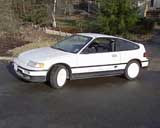
Year 1995. I got interested to try this hobby project when received an ad in the mail to buy some
electronics books and among them - "Build your own electric car" now classic by Bob Brandt. Curious, I've
ordered the book, and they've described whole process step by step. Also they offer a VHS
tape called "Quiet revolution". Turns out that hundreds converted to electric
power cars are un use today, especially in California because of high concentration of
high tech companies and toughest standards on the emission levels in the country. There
are workshops which will teach you convert a car over weekend, there are businesses where
you can drop off your suitable for conversion car and pick it up in a week never needing
again to pay for gas, change oil, pass emission tests or having broken engine, blown
gasket, torn timing belt or dirty spark plugs simply because you just won't have all this
messy stuff anymore. You'll have only ONE moving part under hood - rotor of your electric
motor. I became inspired so much, that got on the phone looking for the loose parts for
the progect very same evening... Next week I got myself a used Honda CRX, fresh and clean
from the dealership all tuned up only to... take it apart shortly. Overall whole
convertion took me about 3 weeks working full time alone, spread over several month. It
was so satisfying pooling out stose dirty guts out of this car, wiping off oily spots for
the last time! I still have its engine, tank and exhaust system for someone who wants it,
but I knew I'll newer deal with those again.
 Peole ask me: What good does it do to go just 35 miles and get stuck somewhere without a
chance to refuel it on the spot? Answer is simple: if I need greater distance, I take an
other car. The fact of the matter, though, is that most of our daily commute is 10-20
miles. Try to gauge it yourself! Then I plug it in overnight and next morning it's ready
again. (I have to mention that I didn't want to spend $20,000 for good NiMH batteries
which would get me from Portland to Seattle on a single charge easily, but such technology
exists and available). A joy of riding this quiet head turner is unmatched even being
behind the wheel of Ferrary simply because Ferrary is just an exotic variant of the same
old noisy thing... I've used most common and thus inexpensive solution - 27 hp DC motor
bolted through the aluminum adapter plate to the clutch housing as was the engine, and PWM
controller adjusting amount of power delivered to the motor from a set of 10 deep cycle
lead acid batteries connected in series by a thick welding cable. A separate axulaty motor
(blue on this photo) runs AC compressor.
Peole ask me: What good does it do to go just 35 miles and get stuck somewhere without a
chance to refuel it on the spot? Answer is simple: if I need greater distance, I take an
other car. The fact of the matter, though, is that most of our daily commute is 10-20
miles. Try to gauge it yourself! Then I plug it in overnight and next morning it's ready
again. (I have to mention that I didn't want to spend $20,000 for good NiMH batteries
which would get me from Portland to Seattle on a single charge easily, but such technology
exists and available). A joy of riding this quiet head turner is unmatched even being
behind the wheel of Ferrary simply because Ferrary is just an exotic variant of the same
old noisy thing... I've used most common and thus inexpensive solution - 27 hp DC motor
bolted through the aluminum adapter plate to the clutch housing as was the engine, and PWM
controller adjusting amount of power delivered to the motor from a set of 10 deep cycle
lead acid batteries connected in series by a thick welding cable. A separate axulaty motor
(blue on this photo) runs AC compressor.
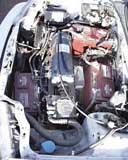 Now, more about the batteries. To balance the car I put three of them in front and seven - on
the back. These poor batteries, they put out about 40A when I'm cruising and close to 300A
when accelerating. This makes a half-inch thick welding cable a little warm. These
batteries are not really designed to take such abuse, so they would last less than
promised 1000 charge-discharge cycles. Even if they will handle 700 cycles and I do it
every night (which I don't) they would last for 700 days or about 2 years. Savings from
the gas, oil and other normal supplies for 2 years break even with the cost of the
batteries ($68 a piece).
Now, more about the batteries. To balance the car I put three of them in front and seven - on
the back. These poor batteries, they put out about 40A when I'm cruising and close to 300A
when accelerating. This makes a half-inch thick welding cable a little warm. These
batteries are not really designed to take such abuse, so they would last less than
promised 1000 charge-discharge cycles. Even if they will handle 700 cycles and I do it
every night (which I don't) they would last for 700 days or about 2 years. Savings from
the gas, oil and other normal supplies for 2 years break even with the cost of the
batteries ($68 a piece).
Antifreeze radiator is gone, but the one cooling off freon is still there. Having AC in
the car is extra weight, energy drain, and actually a luxury here in Oregon's climate, but
I use to live in Texas, you know... Now I should concider pooling this out.
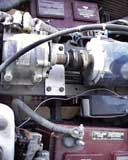
The coupling between the motor and compressor is through a rubber bushing which eliminates
the stress on the bearings due to inevitable inaccuracy and thus non-coaxial mounting of
these two units.
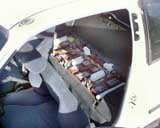
For the batteries behing the driver's seat I had to cut out a rectangular hole in the
bottom of the body and weld together a metal box holding seven batteries. A copper strips
used to connect the batteries together ensuring that terminals won't break off when
batteries move because of vibration. Bottom of the metal box is flush with underbody,
lowering the center of the gravity of the car as much as possible.
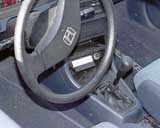
Interior view didn't change much other than I got two meters to monitor voltage on the
battery pack under load and the current while driving.
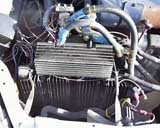
I've opted for off-the-shelf controller because I wanted to complete project faster, but
mainly because by using own design I would loose the warranty on the motor. People came up
with many neat improvements of existing models, such as regenerative braking recuperating
energy back to the batteries, or making it act also as on-board charger saving weight and
the cost.
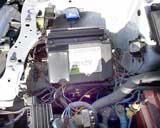
Another essential unit is DC-DC converter (120VDC to 12VDC) to run head and tail lights,
fans, radio or any other "normal" 12V electric appliance in the car.
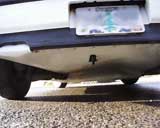
Since there is no exhaust system hanging underneath, I've covered all nderbody with solid
sheet of white plastic isolating from the moisture and greatly reducing air drag
resistance at high speeds. For that reason there are flat wheel covers flush with outer
side of the tire. I won't talk about aestetics here, but it also looks cool and unusual.

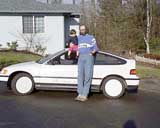
Overall this was exciting project and I am very pleased with the outcome. I use it for local commute
and it serves the purpose flawlessly. Besides knowing that I save environment and reduce
noise, the pride of the accomplishment and ownership of the product of own creativity is really
thrilling and well worth the effort!

You can email me to: portland@usa.com
This and all referenced
pages, except when noted, are copyrightę 1998 Victor Tikhonov










